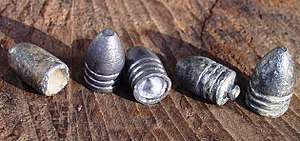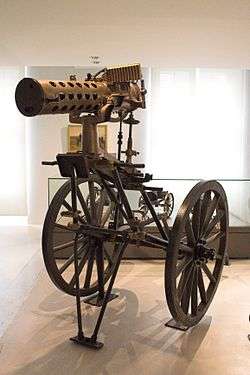Minié ball
The Minié ball, or Minni ball, is a type of muzzle-loading spin-stabilized bullet for rifled muskets named after its developer, Claude-Étienne Minié, inventor of the French Minié rifle. It came to prominence in the Crimean War[1] and American Civil War.


Rifling, the addition of spiral grooves inside a gun barrel, imparts a spin to a bullet, greatly increasing the range and accuracy of a gun. Prior to the Minié ball, balls had to be jammed down the rifle barrel, sometimes with a mallet, and after a relatively small number of shots, gunpowder residue built up in the spiral grooves, which then had to be cleaned out.[2] The development of the Minié ball was significant, because it was the first projectile that was small enough to be easily put down the barrel of a rifled long gun. Both the American Springfield Model 1861 and the British Pattern 1853 Enfield rifled muskets, the most common weapons used during the American Civil War, used the Minié ball.[3]
Designs
The Minié ball is a conical bullet with three exterior grease-filled grooves and a conical hollow in its base. The bullet was designed by Minié with a small iron plug and a lead skirting. Its intended purpose was to expand under the pressure of the powder deflagration, pressing the skirt out to grip the rifling, and secondarily to obturate the barrel and increase muzzle velocity.
The precursor to the Minié ball was created in the 1830s by the French Army captains Montgomery and Henri-Gustave Delvigne. Their design was made to allow rapid muzzle loading of rifles, an innovation that brought about the widespread use of the rifle rather than the smoothbore musket as a mass battlefield weapon. Delvigne had invented a ball that could expand upon ramming to fit the grooves of a rifle in 1826.[4] The design of the ball had been proposed in 1832 as the cylindro-conoidal bullet by Captain John Norton,[5] but had not been adopted.
Captain James H. Burton, an armorer at the Harpers Ferry Armory, developed an improvement on Minié's design when he added a deep cavity at the base of the ball, which filled up with gas and expanded the bullet's rim upon firing. The result was not only better range, but also a cheaper bullet, which was used in the Crimean War and then the American Civil War.[2] Burton's version of the ball weighed 1.14 ounces.[6]
Use
The bullet could be quickly removed from the paper cartridge with the gunpowder poured down the barrel and the bullet pressed past the muzzle rifling and any detritus from prior shots. It was then rammed down the barrel with the ramrod, which ensured that the charge was packed and the hollow base was filled with powder. When the rifle was fired, the expanding gas pushed forcibly on the base of the bullet, deforming the skirt to engage the rifling. This provided spin for accuracy, a better seal for consistent velocity and longer range, and cleaning of barrel detritus.
Effects
Wounds inflicted by the conical Minié ball were different from those caused by the round balls from smoothbore muskets, since the conical ball had a higher muzzle velocity and greater mass, and easily penetrated the human body.[6] Round balls tended to remain lodged in the flesh, and they were often observed to take a winding path through the body. Flexed muscles and tendons, as well as bone, could cause the round ball to deviate from a straight path. The Minié ball tended to cut a straight path and usually went all the way through the injured part; the ball seldom remained lodged in the body. If a Minié ball struck a bone, it usually caused the bone to shatter.[7] The damage to bones and resulting compound fractures were usually severe enough to necessitate amputation.[7][8] A hit on a major blood vessel could also have serious and often lethal consequences.[6]
One of the more famous documented cases involving Minié ball injuries concerned a Confederate soldier wounded during Jubal Early's raid on Washington, D.C. on July 12, 1864. The soldier, a private in the 53rd North Carolina Infantry, was hit in the side of the head by a .58 caliber Minié ball, which shattered his skull and lodged in the right hemisphere of the brain. He went into convulsions and became paralyzed on one side of his body, but started recovering within eight days of being hospitalized. However, within three more days, his condition deteriorated and he eventually lost consciousness and died, having survived with his wound for 16 days. An autopsy of the soldier found that the right hemisphere of the brain was extensively damaged and large areas of it had necrosed. The brain was removed, preserved in formaldehyde and donated to the Army Museum in Washington. The primary cause of death had been infection caused by both the initial injury and subsequent necrosis of brain tissue.[9]
See also
References
Notes
- Institute, Author Civil War (2019-04-30). "Small but Deadly: The Minié Ball". The Gettysburg Compiler. Retrieved 2019-12-10.
- McPherson, James M. (1988) Battle Cry of Freedon: The Civil War Era Oxford University Press. p.474 ISBN 0-19-503863-0
- Keegan, John (2009) The American Civil War: A Military History New York; Knopf. p.55 ISBN 978-0-307-26343-8
- Fadala, Sam (2006). The Complete Black Powder Handbook: The Latest Guns and Gear (5th ed.). Gun Digest Books. p. 144. Retrieved 2010-05-14.
- O'Connelll, Robert L. (1990). Of Arms and Men: A History of War, Weapons, and Aggression. Oxford University Press US. p. 191. Retrieved 2010-05-14.
- Keegan, John (2009) The American Civil War: A Military History New York; Knopf. pp.314-15 ISBN 978-0-307-26343-8
- Manring, M. M.; Hawk, Alan; Calhoun, Jason H.; Andersen, Romney C. (14 February 2009). "Treatment of War Wounds: A Historical Review". Clinical Orthopaedics and Related Research. 467 (8): 2168–2191. doi:10.1007/s11999-009-0738-5. PMC 2706344. PMID 19219516.
- Chisolm, Julian (1864). A manual of military surgery, for the use of surgeons in the Confederate States army; with explanatory plates of all useful operations. Columbia: Evans and Cogswell. p. 119.
- "Medical and Surgical Reporter", 1865 Vol XIII
Bibliography
- Brent Nosworthy (2003). The Bloody Crucible of Courage, Fighting Methods and Combat Experience of the Civil War. Carroll and Graf Publishers. ISBN 0-7867-1147-7.
- "The lead minie ball". CivilWar@Smithsonian.
External links
- Weaponry: The Rifle-Musket and the Minié Ball- Allan W. Howey, for the Civil War Times magazine
